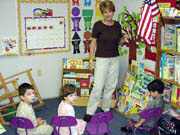Back in 1974, North Bergen High School teacher Mary Janesak attended a conference where she learned of a program called the Child Development Laboratory Class. It would enable high school students the opportunity to work with pre-school students as part of the regular curriculum at the high school.
"Cranford High School was the pilot school for the program, but I thought it was a marvelous idea," Janesak said. "The state Department of Education was encouraging the program. At the time, pre-school was a wide-open field and not a lot of people were looking into pre-schools. I thought it was great for us."
Some 27 years later, the program still flourishes – almost in anonymity – at the high school. It started with 12 high school students teaching 12 four-year-old students. Since the North Bergen Board of Education received a state mandate to begin 4-year-old Early Childhood classes, which began in September, the high school program now includes 3-year-olds.
This year, nearly 80 North Bergen High School students are getting the chance to work with more than 30 pre-school age toddlers three times a week as part of their regular curriculum.
"It develops a positive attitude toward learning in the future," Janesak said. "Many of my students are studying early childhood in college. Some others go right to work in a day care center right away. I constantly get calls from centers who are looking for qualified people. And our students are definitely qualified. They get a chance to understand children at an early age, relate to the children and give the students a chance to study the child’s development first hand."
Parents leave their children at the school three times a week – Tuesdays, Wednesdays and Thursdays – and the high school students are in charge, working with the toddlers, giving them instruction while also learning a lot about themselves in the process.
Yenexis Quintana is a 17-year-old senior who has taken the Child Development class.
"I always loved children, but by being in this program, it has given me a new perspective about being with children," Quintana said. "The children open up to you and admire you. You see them learn and grow up so fast. It really is great."
The class has had such an impact on Quintana that she wants to study child psychology in college next year.
"I got a chance to see what teachers go through in terms of dealing with students of early childhood age," Quintana said. "I have a better understanding of what teachers do. It is a great amount of responsibility for any student, but I think it helps that we have a lot of students in the high school who care about kids. I love it. It’s not just a class to me. It’s fun. And I want to make a career of it."
Jennifer Francisco already is on her way to having a career, after getting her start with the Child Development Lab. Francisco, 19, is a freshman at St. Peter’s College, majoring in education and child psychology.
"I knew I liked kids before hand, but this class made me appreciate children even more," Francisco said. "Honestly, when I got to work with the kids, I was able to relieve so much stress."
Try telling that to the mother who spent hours trying to dress the 3-year-old to get him/her to the school.
"It really took the stress right out of me," Francisco said. "I couldn’t wait to get to see the kids. I wanted to teach them. I wanted to help them. I learned so much from taking that class. And I recommended the class to everybody."
Janesak said that the program will be improved immensely in future weeks, when the restoration and renovation to the school’s Home Economic classrooms are completed. Right now, the classes have been held in the cafeteria.
Laboratory class
Vice-principal Patricia Brando explained that the pre-school actually has to be classified as a "laboratory" rather than an official "pre-school" because the school does not own a pre-school certificate.
On the high school level, the classes are junior and senior electives, part of the home economics curriculum.
"A teacher is there and the students are learning as they work with the youngsters," said Brando, who was the supervisor of the program for a few years, before Janesak took the program over again a few years ago. "It’s a regular class for anyone who wants to have the chance to learn how to work with children. It gives them the incentive to want to major in early education in college. But it’s treated just like any other class in the school."
There is a limit to the amount of students who can first enroll in the elective, as well as the amount of pre-schoolers that the school can hold.
"We’re able to take about 30-to-35 little ones," Brando said. "We can’t have too many. And we have a nice graduation ceremony for the little ones at the end of the year. They get all dressed up, in caps and gowns. It’s really nice to see."
There is also one limitation to the participants.
"We have to make sure everyone is potty trained," Brando said. "That’s the only stipulation."
For the students and the student teachers alike.
The cost is minimal for the parents, who are asked to contribute $15 for juice and snacks for the entire year.
The course is so popular that Brando said that "we have to practically hold a lottery to see who gets to take the course."
"The parents want it, the students want it," Brando said. "It’s a win-win."
One that makes Janesak proud.
"We’ve been able to pass our curriculum over to two other districts who then put it in their school," Janesak said. "That definitely makes us feel good. We’re able to pass it on."
